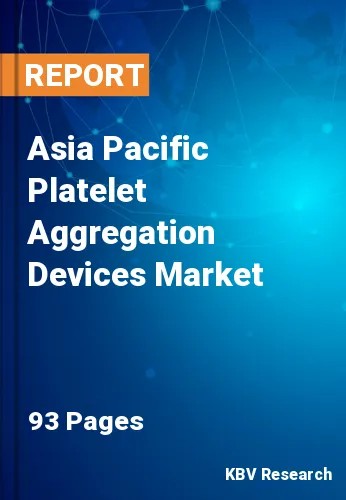The Asia Pacific Platelet Aggregation Devices Market would witness market growth of 6.2% CAGR during the forecast period (2023-2030).
Biohybrid robots can create environments that closely mimic physiological conditions by incorporating biological components. This is crucial for studying platelet function in a context that more accurately represents the human body's complexities. Insights gained from biohybrid robot studies may contribute to innovations in therapeutic approaches. The development of targeted therapies and interventions may be facilitated by a more comprehensive understanding of platelet behavior.
In addition, drawing inspiration from the human brain, neuro-inspired computing is making its mark in these devices. This innovation involves designing algorithms and architectures that emulate neural networks' parallel processing and learning capabilities. Incorporating neuro-inspired computing enhances consumer robots' cognitive abilities, enabling more sophisticated interactions and adaptability. These devices equipped with neuro-inspired computing exhibit enhanced cognitive capabilities by replicating the brain's parallel processing. This allows for the simultaneous analysis of multiple facets of platelet function, providing a more comprehensive understanding.
As per the data from Invest India, in FY17, the hospital sector in India was valued at $61.79 billion; by 2023, that figure is projected to increase to $132 billion. In addition, AB-Pradhan Mantri Jan Arogya Yojana (AB-PMJAY) provides cashless, secondary, and tertiary hospitalization care at no cost to approximately 500 million impoverished and disadvantaged individuals. Additionally, China has been witnessing a notable increase in the incidence of cardiovascular diseases. Lifestyle changes, dietary habits, and an aging population contribute to a higher prevalence of conditions requiring advanced diagnostic tools like these devices. As per the data released in 2023 from the Shanghai Municipal People's Government, there are more than 300 million people with cardiovascular diseases in China, and the average age of patients is becoming younger, imposing serious burdens on individuals, families, and the public health system. Hence, the growing number of cardiovascular disease cases and the hospital sector will assist in the expansion of the regional market.
The China market dominated the Asia Pacific Platelet Aggregation Devices Market by Country in 2022, and would continue to be a dominant market till 2030; thereby, achieving a market value of $75.9 Million by 2030. The Japan market is registering a CAGR of 5.6% during (2023 - 2030). Additionally, The India market would showcase a CAGR of 6.9% during (2023 - 2030).
Free Valuable Insights: The Global Platelet Aggregation Devices Market is Predict to reach $1.1 Billion by 2030, at a CAGR of 5.5%
Based on Product, the market is segmented into Consumables & Accessories, and Systems & Instruments. Based on End-Use, the market is segmented into Research & Academic Institutes, Hospital, and Diagnostic Centers. Based on Application, the market is segmented into Research, and Clinical. Based on countries, the market is segmented into China, Japan, India, South Korea, Singapore, Malaysia, and Rest of Asia Pacific.
By Product
By End-Use
By Application
By Country
Our team of dedicated experts can provide you with attractive expansion opportunities for your business.

